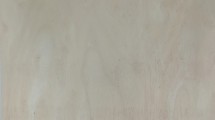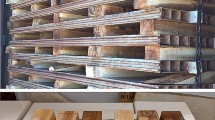Abstract
In this study, the properties of laminated veneer lumber (LVL) made from oil palm trunks (OPT) were evaluated in comparison with rubberwood using cold setting adhesives, namely, emulsion polymeric isocyanate (EPI) and polyvinyl acetate (PVAc). The evaluations were based on either dry or after cold water, hot water and cyclic pre-treatment. The density of the OPT LVL was slightly higher than that of solid OPT. Thickness swelling and water absorption of OPT LVL were greater than of rubberwood LVL. Pre-treatment increased the water absorption and thickness swelling. The OPT LVL bonded with EPI without toluene showed greater water absorption and thickness swelling than EPI with toluene. Pre-treatment significantly reduced the tensile strength of OPT LVL. The OPT LVL bonded with EPI without toluene showed higher tensile shear strength, but a greater reduction of tensile shear strength after pre-treatment, than the OPT LVL bonded with EPI and toluene. The PVAc adhesive had greater wettability than the EPI. The EPI without toluene showed a lower contact angle than the EPI with toluene. The loose side of the OPT veneer was found to have greater wettability than the tight side.
Zusammenfassung
Die Eigenschaften von Furnierschichtholz (LVL) aus Ölpalmenholz (OPT) hergestellt unter Verwendung von kalt härtenden Klebstoffen, namentlich Emulsions-Polymerisocyanat (EPI) und Polyvinylazetat (PVAc), wurden untersucht und mit denjenigen von LVL aus Gummibaumholz verglichen. Die Untersuchungen wurden an unbehandelten Proben oder nach einer Kaltwasser-, Heißwasser- und zyklischen Vorbehandlung durchgeführt. Die Dichte von OPT LVL war etwas höher als die Dichte von massivem Ölpalmenholz. Die Dickenquellung und die Wasserabsorption von OPT LVL waren größer als die von Gummibaum LVL. Eine Vorbehandlung hatte eine höhere Wasserabsorption und Dickenquellung zur Folge. Mit EPI ohne Toluen verklebtes OPT LVL wies eine höhere Wasserabsorption und Dickenquellung auf als Proben, die mit EPI mit Toluen verklebt wurden. Durch eine Vorbehandlung wurde die Zugfestigkeit von OPT LVL signifikant reduziert. Für EPI ohne Toluen verklebtes OPT LVL ergab sich eine höhere Zugscherfestigkeit, jedoch nahm diese nach einer Vorbehandlung stärker ab als bei mit EPI mit Toluen verklebtem OPT LVL. Der PVAc-Klebstoff hatte eine höhere Benetzbarkeit als der EPI-Klebstoff. EPI ohne Toluen hatte einen niedrigeren Kontaktwinkel als EPI mit Toluen. Die offene Seite des OPT Furniers zeigte eine höhere Benetzbarkeit als die geschlossene Seite.




Similar content being viewed by others
References
ASTM D3502-76 (1981) Standard test method for moisture absorption of compressed wood products
Aydin I, Çolak S, Çolakoglu G, Salih E (2004) A comparative study on some physical and mechanical properties of laminated veneer lumber (LVL) produced from Beech (Fagus orientalis Lipsky) and Eucalyptus (Eucalyptus camaldulensis Dehn.) veneers. Holz Roh- Werkst 62(3):218–220
Basiron Y (2007) Palm oil production through sustainable plantations. Eur J Lipid Sci Technol 109:289–295
BS6566: Part 8 (1985) Specification for bond performance of veneer plywood
Çolak S, Aydin I, Demirkir C, Çolakoglu G (2004) Some technological properties of laminated veneer lumber manufactured from Pine (Pinus sylvestris L.) veneers with melamine added—UF resins. Turk J Agric For 28:109–113
Eckelman CA (1993) Potential uses of laminated veneer lumber in furniture. Forest Prod J 43(4):19–24
Gillespie RH (1984) Evaluating durability of adhesive-bonded wood joints. Noyes Publications, Park Ridge
Goulding TM (1983) Polyvinyl acetate wood adhesive. In: Pizzi A (ed) Wood adhesive. Dekker, New York/Basel, pp 319–350
Hayashi T, Oshiumo S (1993) Bending strength distribution of laminated-veneer-lumber for structural use. Mokuzai Gakkaishi 39:985–992
Kim S, Kim HJ (2006) Study of miscibility of melamine-formaldehyde resin and poly(vinyl acetate) blends for use as adhesives in engineered flooring. J Adhes Sci Technol 20:209–219
Mohamad H, Zakaria ZZ, Hassan AH (1989) Potentials of oil palm by-products as raw materials for agro-based industries. In: Proceedings of the PORIM International Palm Oil Development Conference, Kuala Lumpur, Malaysia
Nordin K, Jamaludin MA, Ahmad M, Samsi HW, Salleh AH, Jallaludin Z (2004) Minimising the environmental burden of oil palm trunk residues trough the development of laminated veneer lumber products. Manage Environ Qual 15:484–490
Qiao L, Easteal AJ (2001) Aspect of the performance of PVAc adhesives in wood joints. Pigm Resin Technol 30(2):79–87
Qiao L Easteal AJ, Bolt CJ, Coveny PK, Franich RA (2000) Improvement of water resistance of poly(vinyl acetate) emulsion wood adhesive. Pigm Resin Technol 29(3):152–158
Shukla S, Kamdem D (2008) Properties of laminated veneer lumber (LVL) made with low density hardwood species: effect of the pressure duration. Holz Roh- Werkst 66(2):119–127
Sulaiman O, Hashim R, Wahab R, Wan Samsi H, Mohamed AH (2008) Evaluation on some finishing properties of oil palm plywood. Holz Roh- Werkst 66(1):5–10
Vázquez G, González-Álvarez J, López-Suevos F, Antorrena G (2003) Effect of veneer side wettability on bonding quality of Eucalyptus globulus plywoods prepared using a tannin–phenol–formaldehyde adhesive. Bioresour Technol 87(3):349–353
Wahab R, Hashim WS, Mohamed A, Sulaiman O (2008) Utilisation potential of 30 year-old oil palm trunks laminated veneer lumbers for non-structural purposes. J Sustain Dev 1(3):109–113
Yamamoto K, Simatupang MH, Hashim R (1998) Caoutchouc in teak wood (Tectona grandis L.f.): formation, location, influence on sunlight irradiation, hydrophobicity and decay resistance. Holz Roh- Werkst 56(3):201–209
Acknowledgements
The authors acknowledge the financial support of the Ministry of Science, Technology and Innovation, Science Fund Grant (03-01-05-SF0082), Universiti Sains Malaysia, Central Kedah Plywood Factory Sdn. Bhd., and Casco Adhesives Sdn. Bhd.
Author information
Authors and Affiliations
Corresponding author
Rights and permissions
About this article
Cite this article
Hashim, R., Sarmin, S.N., Sulaiman, O. et al. Effects of cold setting adhesives on properties of laminated veneer lumber from oil palm trunks in comparison with rubberwood. Eur. J. Wood Prod. 69, 53–61 (2011). https://doi.org/10.1007/s00107-009-0405-2
Received:
Published:
Issue Date:
DOI: https://doi.org/10.1007/s00107-009-0405-2




